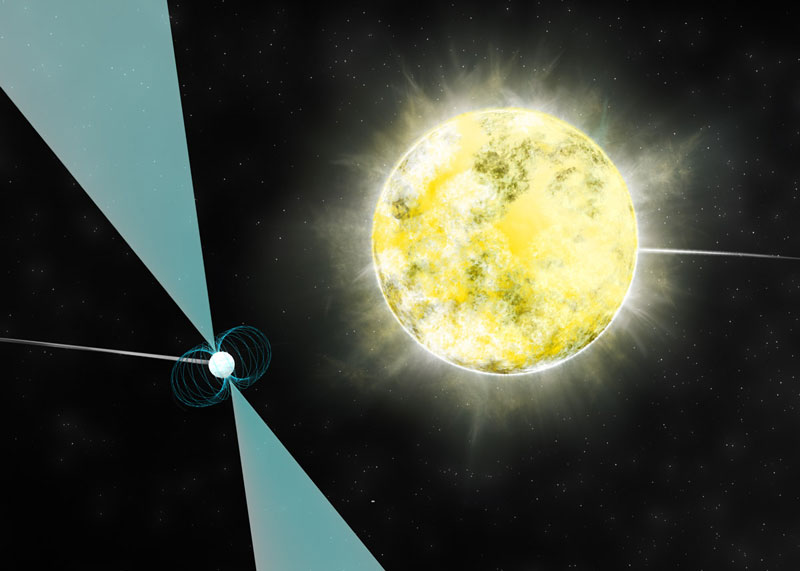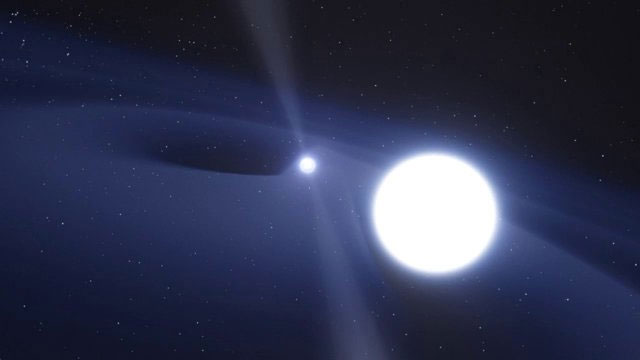
آیا این بزرگترین جواهر هستی است ؟ محققان دانشگاه ویسکانسین میلواکی موفق به شناسایی سردترین و کمنورترین ستاره کوتوله سفید شدند که اندازه ای برابر زمین دارد و از الماس ساخته شده است.
سرمای این ستاره به حدی است که کربن آن بلوری شده و این ستاره را به الماسی به اندازه زمین تبدیل کرده است. ستاره کوتوله سفید مذکور در فاصله ۹۰۰ سال نوری از زمین و در مسیر صورتفلکی دلو قرار دارد. محققان این جواهر ستارهای را با استفاده از تلسکوپ گرین بانک رصدخانه رادیویی ملی نجوم و مجموعه تلسکوپهای VLBA در کنار رصدخانههای دیگر شناسایی کردند.

جسم مورد مطالعه دانشمندان موسوم به PSR J2222-0137 از سنی مشابه کهکشان راهشیری، حدود ۱۱ میلیارد سال برخوردار است. تپاخترها به ستارگان نوترونی با چرخش بسیار بالا گفته میشود که بقایای فوق متراکم ستارگان عظیمی هستند که به شکل ابرنواختر منفجر شده بودند. با چرخش ستارگان نوترونی،پرتوهای صاعقه مانند امواج رادیویی از قطبهای میدان مغناطیسی قدرتمند آنها در فضا منتشر میشود. هنگامی که یکی از این پرتوها از زمین میگذرد، تلسکوپهای رادیویی میتوانند پالس امواج رادیویی را ثبت کنند.

تپاختر همراه ستاره PSR J2222-0137 اولین جسم در این سیستم بود که کشف شد. در حقیقت موقعیت تصادفی این کوتوله سفید در سیستمی دوتایی با یک ستاره نوترونی به ستارهشناسان امکان شناسایی آن را داد. این سیستم با استفاده از تلسکوپ گرین بانک شناسایی و سپس در یک دوره دو ساله توسط رصدخانه VLBA برای نمایش موقعیت و فاصله آن از زمین مورد بررسی قرار گرفت. بر اساس محاسبات محققان، دمای این کوتوله سفید نباید بیشتر از ۳۰۰۰ کلوین باشد که دمای نسبتا سردی است. دمای مرکز خورشید حدود ۵۰۰۰ برابر گرمتر است.
کوتولههای سفید، شکل پایانی بسیار متراکم ستارگانی مانند خورشید هستند که برای ایجاد جسمی تقریبا به اندازه زمین فروریختهاند. این ستارگان بیشتر از کربن و اکسیژن ساخته شده و به آرامی و در طول میلیونها سال سرد و محو میشوند.
منبع : universetoday
We live in a vast, dark Universe, which makes the smallest and coolest objects extremely difficult to detect, save for a stroke of luck. Often times this luck comes in the form of a companion. Take, for example, the first exoplanet detected due to its orbit around a pulsar — a rapidly spinning neutron star.
A team of researchers using the National Radio Astronomy Observatory’s Green Bank Telescope and the Very Long Baseline Array (VLBA), as well as other observatories have repeated the story, detecting an object in orbit around a distant pulsar. Except this time it’s the coldest, faintest white dwarf ever detected. So cool, in fact, its carbon has crystallized.
The punch line is this: with the help of a pulsar, astronomers have detected an Earth-size diamond in the sky.
“It’s a really remarkable object,” said lead author David Kaplan from the University of Wisconsin-Milwaukee in a press release. “These things should be out there, but because they are so dim they are very hard to find.”
The story begins when Dr. Jason Boyles, then a graduate student at West Virginia University, identified a pulsar, dubbed PSR J2222-0127, 900 light-years away in the constellation Aquarius.
When the core of a massive star runs out of energy, it collapses to form an incredibly dense neutron star or black hole. Bring a teaspoon of neutron star to Earth and it would outweigh Mount Everest at about a billion tons. A pulsar is simply a spinning neutron star.
But as a pulsar spins, lighthouse-like beams of radio waves stream from the poles of its powerful magnetic field. If they sweep past the Earth, they’ll give rise to blips of radio waves, so regular that you could set your watch by them. But if the pulsar carries a companion in tow, the tiny gravitational tugs can offset that timing slightly.
The first observations of PSR J2222-0137 identified that it was spinning more than 30 times each second. It was then observed over a two-year period with the VLBA. By applying Einstein’s theory of relativity — which predicts that light slows in the presence of a gravitational field — the researchers studied how the gravity of the companion warped space, causing delays in the radio signal as the pulsar passed behind it.
The delayed travel times helped the researchers determine the individual masses of the two stars. The pulsar has a mass of 1.2 times that of the Sun and the companion a mass 1.05 times that of the Sun. Previously, researchers had thought the companion was likely another neutron star, or a white dwarf, the remnant of a Sun-like star.
But the timing variations made the neutron star scenario unlikely. The orbits were too orderly for a second supernova to have taken place. So knowing the typical brightness of a white dwarf and its distance, astronomers initially thought they would be able to detect the elusive companion in optical and infrared light.
 گجت نیوز آخرین اخبار تکنولوژی، علم و خودرو
گجت نیوز آخرین اخبار تکنولوژی، علم و خودرو 





